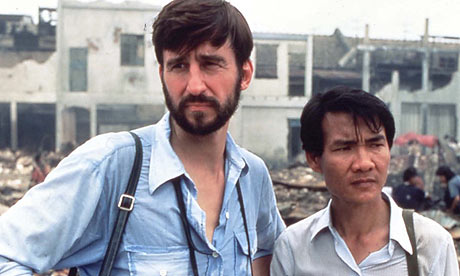Sweet Smell of Success
Directed by Alexander Mackendrick
Starring Burt Lancaster, Tony Curtis
The dark, seedy world of 1950s America has provided an array of classic noir films renowned for quick talking, sharply dressed characters and corrupt, dazzling cities full of people wanting to make money by any means necessary. This atmospheric genre is epitomised in Sweet Smell of Success as it examines the dark side of the journalist and the power they have to manipulate people.
Sweet Smell of Success centres on two characters in differing positions of power: J.J. Hunsecker, an influential national columnist, and Sidney Falco, a publicist willing to do anything to make money, including Hunsecker’s dirty work.
Co-written by Ernest Lehman, who went on to write the screenplay for West Side Story and The Sound of Music, the film is filled with witty dialogue and sharp interactions creating humour as well as drama. Having worked as a journalist and a publicist before turning to screenwriting, Lehman’s account of the greed and cut-throat nature of journalism gives the audience a different perspective of the profession. The journalist is not a ‘public watchdog,’ uncovering the truth for the good of the people.
Instead, we are given an insight into the ruthlessness of show business and the worth of being mentioned in a national newspaper column. The need for actors and singers to get noticed by national publications creates the environment for publicists like Falco to do whatever it takes to fulfil promises that can’t be guaranteed.
Although the film was a Box Office disaster, critics have praised the film’s superb camera work and New York vernacular. In 2002 the musical version of the film was created and Time ranked Sweet Smell of Success as one of the “All-Time 100 Movies,” marking it as one of the most significant journalist genre films of the 20th century.
Wednesday 6 March 2013
Tuesday 26 February 2013
The Killing Fields
The Killing Fields
Directed by Roland Joffé
Starring Sam Waterston, John Malkovich, Haing S. Ngor
Directed by Roland Joffé
Starring Sam Waterston, John Malkovich, Haing S. Ngor
Academy Award winning director Francis Ford Coppola said in
1979 that “quality and integrity” are the two things that make a great movie.
Five years later, Roland Joffé’s directorial debut, The Killing Fields, epitomised
those two characteristics with 141 minutes of emotional, powerful and awe-inspiring
film.
The story of Sidney Schanberg and Dith Pran is one of
friendship amidst the harsh and terrifying realities of the war in Cambodia
during the 1970s. Through the uncensored images of dead bodies and executions the
audience is delivered a realistic view of life for, not just a journalist, but
also a native in Cambodia at the time of the Vietnam War.
Pat Golden’s casting of Haing S. Ngor, a survivor of the
Khmer Rouge and its labour camps, as Pran was a great success, allowing the
debut actor to pick up the Oscar for Best Supporting Actor – the first male
Asian actor to do so.
The Killing Fields
gives an insight into the risk taken by war reporters every day, bringing to
life the efforts of many journalists who have risked their lives in order to
bring people the news from across the world. But the overriding theme is one of
friendship between two men who would stand by each other even in the face of
death.
Critically acclaimed, the film won three Oscars, with a
further four nominations and 26 other awards from several institutions.
Watching this film, it is unsurprising to see why it has been rated as one of the 'greatest tearjerkers' of all time, grasping a sense of happiness, relief and raw emotion through the reuniting of Sidney and Pran in the final scene, as John Lennon's 'Imagine' plays over the top. A sensational film that provides everything an audience wants. A true masterpiece.
Watching this film, it is unsurprising to see why it has been rated as one of the 'greatest tearjerkers' of all time, grasping a sense of happiness, relief and raw emotion through the reuniting of Sidney and Pran in the final scene, as John Lennon's 'Imagine' plays over the top. A sensational film that provides everything an audience wants. A true masterpiece.
Monday 11 February 2013
Good Night, and Good Luck
Good Night, and Good Luck
Directed by George Clooney
Starring George Clooney, David Strathairn, Robert Downey Jr.
“We will not walk in fear, one of another” – the hard-hitting
words of Edward R. Murrow who used television to bring down Senator Joseph
McCarthy in the 1950’s. Good Night, and
Good Luck accurately captures
Murrow’s attempts to stop McCarthy, integrating historical footage of McCarthy
and the trial of Annie Lee Moss which adds to the realism.
The film, released in 2005, was George Clooney’s second
feature film as director. Clooney’s views on Darfur made the headlines a year
after the film was released and he has
backed Barack Obama’s presidential campaigns, indicating his strong political
opinions and possible motive for wanting to re-tell the story of Murrow. The
film was nominated for six Oscars and ranked 89th on the list of
highest grossing films of 2005.
Although the film covers the story of Murrow in immense
detail, it is slow paced and at times appears static. The story is interesting
and one worth telling, bringing to
attention the issues of the 1950’s and the worry over Communism within the
American government at the time, as well as the way Murrow invented television
as a powerful medium. But in making sure the film is accurate it loses its
appeal to a wider audience and serves only as a cinematic account of this
monumental era in recent American history.
There is no doubting the quality of stylistic features
used in Good Night, and Good Luck. Its
use of close-ups and shadowed lighting capture the controversial nature and
pressure Murrow and the men behind See it
Now were under. Fifty years on from See
it Now, the film acts as an interesting insight into the actions of one
television journalist who affected the lives of many Americans for the better.
Monday 4 February 2013
All the President's Men
All the President’s
Men
Directed by Alan J. Pakula
Starring Dustin Hoffman, Robert Redford
Directed by Alan J. Pakula
Starring Dustin Hoffman, Robert Redford
On the face of it, a story about two journalists working for
the Washington Post may seem somewhat
dull. However, a story about the discovery of one of America’s biggest
political scandals makes for a thrilling and insightful look into the workings
of the journalists who uncovered the truth.
The story of Bob Woodward and Carl Bernstein is told to
perfection by All the President’s Men
and displays the cover up of President Nixon to its full extent. Although the
film is centred around the Watergate scandal, it also shows the inner workings
of American newspapers in the 1970’s. Cramped office floors, heavily debated
editorial meetings and the intense pursuit of leads all allow the story to come
to life.
Throughout, the theme of government cover up is apparent,
matched by the lack of belief in the story’s credibility by the Washington Post editors. The appearance of
Deep Throat, an unnamed source at the time, later revealed to be FBI Associate
Director Mark Felt, marked speculation over his identity for decades to come
and gave life to one of the most famous anonymous sources in American history.
The film was a success in 1976, landing fourth spot on the
highest grossing films of that year behind Rocky,
To Fly! and A Star is Born. It also won four Oscars, including Best Supporting
Actor, and was nominated for a further four awards.
Take away the factual element of the story and you have a
stand-alone detective film that leaves the audience attempting to uncover the
truth as they watch. Although classed as a political thriller, it makes a case
for a whole new genre based on the workings of a journalist. Whether you know
the story of Watergate or not, it’s a must watch.
Wednesday 23 January 2013
The Girl Who Kicked the Hornet's Nest
Hello again. As with all my endeavours, I have returned after a long leave of absence which I have no reason for taking. I would present you with the excuse that I have been busy but everyone knows students have far too much free time on their hands.
The reason for returning isn't simply random, nor is it because I thought to myself 'I must write something just to make my blogs seem active'. Luckily, as I near the end of my university life, one of my Journalism modules requires me to watch a film and review it every week. So I thought I'd use those to reinvigorate this blog, that never really got into a flow of things.
There will be a reoccurring theme of journalists within these reviews, which you would expect from a module titled 'Journalists on the Screen'. So I hope you enjoy, maybe it'll give you some inspiration to watch some of these films that you might normally ignore.
The reason for returning isn't simply random, nor is it because I thought to myself 'I must write something just to make my blogs seem active'. Luckily, as I near the end of my university life, one of my Journalism modules requires me to watch a film and review it every week. So I thought I'd use those to reinvigorate this blog, that never really got into a flow of things.
There will be a reoccurring theme of journalists within these reviews, which you would expect from a module titled 'Journalists on the Screen'. So I hope you enjoy, maybe it'll give you some inspiration to watch some of these films that you might normally ignore.
-----------------------------------------------------------------------
The Girl Who Kicked
the Hornet’s Nest
Directed by Daniel Alfredson
Directed by Daniel Alfredson
As with all film trilogies, the trick to a successful final
chapter is to encompass everything from the first two films and tie the story
into a securely fastened knot, leaving the audience happy to have taken their
time to watch all three instalments. Add in the fact that the film is an
adaptation and you have even more expectation to do the novel justice.
Thankfully, fans of the books and films will be pleased with the way this dark,
gritty drama comes to a climax, allowing for a satisfying conclusion to the
story of Lisbeth Salander’s troubled life.
Having directed The
Girl Who Played with Fire, his first worldwide feature film release, Daniel
Alfredson follows up its success with the final adaptation of Stieg Larsson’s
series of novels. However, Box Office figures tell a story – The Girl Who Kicked the Hornet’s Nest
turned over £15 million less than The
Girl Who Played with Fire and a staggering £38 million less than the first
in the trilogy, The Girl with the Dragon
Tattoo.
Unlike in the first two films, the third follows the work of
the journalists as they attempt to uncover the illegal activities of a secret
organisation within the Swedish government. In following the journalists of Millennium magazine, led by editor
Mikael Blomkvist, the film displays thought provoking theories of government
corruption, as well as a unique look at the police and journalists working
together.
Once you get past the TV production feel and the Swedish
subtitles you can appreciate the hard hitting storyline that neatly ties up the
trilogy, making it a must watch for those who have seen the first two films.
Subscribe to:
Posts (Atom)




